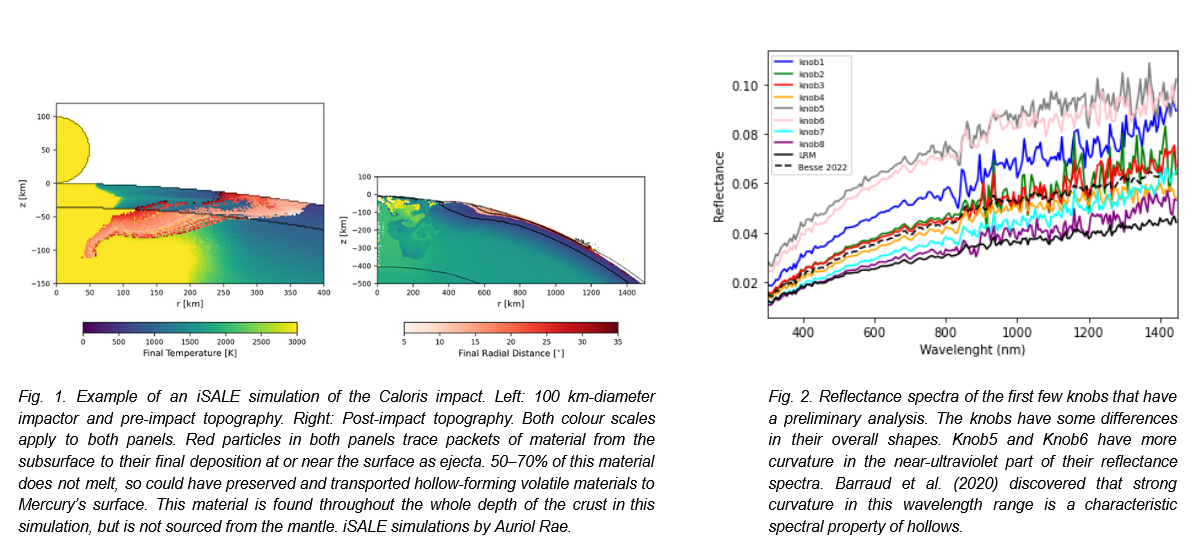P1. Mercury's volatiles - Bepicolombo YSSG-SEIS
Description
MESSENGER results indicate several volatile-driven surface processes on Mercury, including hollow formation and explosive volcanism. The sources and identities of these volatile materials are uncertain.
________________________________________________________________________________________________________________________________________________________________
- Removed a total of (1) style text-align:center;
- Removed a total of (1) style text-align:justify;
- Removed a total of (1) style font-style:italic;
Main questions/goals
- What can we say about the distribution of hollow-forming materials in Mercury’s subsurface?
- What are the spectral responses of Mercury’s hollow-forming materials? Is there any diversity depending on their setting?
- Removed a total of (1) style text-align:center;
- Removed a total of (7) style text-align:left;
Scientists involving in the project
- Jack Wright, ESA, ESAC, Spain (jack.wright@esa.int)
- Emma Caminiti, LESIA - Observatoire de Paris-PSL, France
- Auriol Rae, University of Cambridge
- Océane Barraud, DLR, Germany
- Indhu Varatharajan, Stony Brook University, USA
- Nicolas Bott, Purdue University, USA
- Mireia Leon Dasi, LESIA, Observatoire de Paris, France
- Kaori Hirata, University of Tokyo, Japan
- Sebastien Besse, ESA, ESAC, Spain
- Dave Rothery, Open University
- Removed a total of (1) style text-align:center;
- Removed a total of (12) style text-align:left;
________________________________________________________________________________________________________________________________________________________________
Research highlights
To address the main research questions of the project, we are looking at the circum-Caloris knobs, putative remnant Caloris ejecta blocks. Many of these knobs have a conical shape, which Wright et al. (2020) argue is the result of mass wasting. Wright et al. (2020) also observed hollows in some knobs, which raises the possibility that the knobs could have formed by volatile-loss-driven mass wasting. We are using numerical impact simulations (iSALE, e.g., Fig. 1) to estimate from what depth these knobs were excavated such that they could have transported Mercury’s hollow-forming materials to the surface. We are using MESSENGER/MASCS spectra to investigate if these knobs have distinct spectral properties (e.g., Fig. 2) and we will compare these properties with those of hollows and other terrains on Mercury.

Publications/Abstracts related to the project
- Wright, J., Caminiti, E., Rae, A. S. P., and Besse, S. (2023) Source of Mercury’s Hollow-Forming Materials: preliminary Insights from Impact Simulations and MASCS Spectra, 54th LPSC, Abstract #2092. https://www.hou.usra.edu/meetings/lpsc2023/pdf/2092.pdf
- Wright, J., Caminiti, E., Rae, A. S. P., and Besse, S. (2023) Mercury’s Hollow-Forming Materials: Insights from Impact Modeling and MASCS Spectra of the Caloris Basin, MExAG Annual Meeting 2023, Abstract #6037, oral presentation, https://www.lpi.usra.edu/mexag/meetings/feb2023/mexag2023_program.htm.
- Wright, J., Conway, S. J., Morino, C., Rothery, D. A., Balme, M. R., and Fassett, C. I. (2020) Modification of Caloris ejecta blocks by long-lived mass-wasting: A volatile-driven process?, Earth Planet. Sci. Lett., 549, 116519, https://doi.org/10.1016/j.epsl.2020.116519.
- Removed a total of (2) style text-align:center;
- Removed a total of (2) style text-align:left;
- Removed a total of (1) style text-align:justify;
- Removed a total of (1) style float:none;








































 Sign in
Sign in
 Science & Technology
Science & Technology